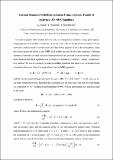Files in this item
Coronal magnetic field extrapolation using a specific family of analytical 3D MHS equilibria
Item metadata
| dc.contributor.author | Nadol, Lilli Maria | |
| dc.contributor.author | Neukirch, Thomas | |
| dc.contributor.author | Wiegelmann, Thomas | |
| dc.date.accessioned | 2023-02-13T15:30:16Z | |
| dc.date.available | 2023-02-13T15:30:16Z | |
| dc.date.issued | 2022-06-27 | |
| dc.identifier | 282566191 | |
| dc.identifier | da6ed501-6397-4a1d-9924-e2f6c22869a7 | |
| dc.identifier.citation | Nadol , L M , Neukirch , T & Wiegelmann , T 2022 , ' Coronal magnetic field extrapolation using a specific family of analytical 3D MHS equilibria ' , 48th EPS Conference on Plasma Physics , Maastricht , Netherlands , 27/06/22 - 1/07/22 . < https://indico.fusenet.eu/event/28/contributions/347/ > | en |
| dc.identifier.citation | conference | en |
| dc.identifier.other | ORCID: /0000-0002-7597-4980/work/124889359 | |
| dc.identifier.uri | https://hdl.handle.net/10023/26964 | |
| dc.description | Funding: LN acknowledges financial support by the University of St Andrews, and TN acknowledges support by the United Kingdom’s Science and Research Council (STFC) via Consolidated Grant ST/W001195/1. | en |
| dc.description.abstract | With current observational methods it is not possible to determine the magnetic field in the solar corona accurately. Therefore, coronal magnetic field models have to rely on extrapolation methods using photospheric magnetograms as boundary conditions. In recent years, due to the increased resolution of observations and the need to resolve non-force-free lower regions of the solar atmosphere, there have been increased efforts to use magnetohydrostatic (MHS) field models instead of force-free extrapolation methods. Although numerical methods to calculate MHS solutions can deal with non-linear problems and hence provide more accurate models, analytical three-dimensional MHS equilibria can also be used as a numerically relatively “cheap” complementary method. We discuss a family of analytical MHS equilibria that allows for a transition from a non-force-free region to a force-free region. The solution involves hypergeometric functions and while routines for the calculation of these are available, this can affect both the speed and the numerical accuracy of the calculations. Therefore, we look into the asymptotic behaviour of this solution in order to numerically approximate it through exponential functions aiming to improve the numerical efficiency. We present an illustrative example by comparing field line profiles, density and pressure differences between the exact solutions, the asymptotic solution and a hybrid model where the use of the hypergeometric function is restricted to an area around the transitional region between the non-force-free and the force-free domain. | |
| dc.format.extent | 4 | |
| dc.format.extent | 9390765 | |
| dc.format.extent | 1415056 | |
| dc.language.iso | eng | |
| dc.subject | QC Physics | en |
| dc.subject | NS | en |
| dc.subject | MCC | en |
| dc.subject.lcc | QC | en |
| dc.title | Coronal magnetic field extrapolation using a specific family of analytical 3D MHS equilibria | en |
| dc.type | Conference poster | en |
| dc.contributor.sponsor | Science & Technology Facilities Council | en |
| dc.contributor.sponsor | Science & Technology Facilities Council | en |
| dc.contributor.institution | University of St Andrews. Applied Mathematics | en |
| dc.description.status | Non peer reviewed | en |
| dc.identifier.url | https://indico.fusenet.eu/event/28/contributions/ | en |
| dc.identifier.url | https://indico.fusenet.eu/event/28/contributions/347/ | en |
| dc.identifier.grantnumber | ST/W001195/1 | en |
| dc.identifier.grantnumber | ST/S000402/1 | en |
This item appears in the following Collection(s)
Items in the St Andrews Research Repository are protected by copyright, with all rights reserved, unless otherwise indicated.

